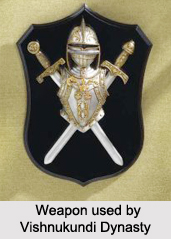 The Pallavas, Chalukyas, Cholas and Vijayanagara are the names of the eminent dynasties and rulers who ruled over vast areas of South India. Historians and laymen are well acquainted with the achievements and stories of these great kings. However, there also existed lesser-known dynasties in the Southern part of India whose contributions to the political, economic, social, cultural and religious history of this region cannot be ignored. One among these is the family of the Vishnukundi kings, who reined major areas of the ancient Andhra region. The height of their power dated between the last quarters of the 4th century A.D. up to the first quarter of the 7th century A.D.
The Pallavas, Chalukyas, Cholas and Vijayanagara are the names of the eminent dynasties and rulers who ruled over vast areas of South India. Historians and laymen are well acquainted with the achievements and stories of these great kings. However, there also existed lesser-known dynasties in the Southern part of India whose contributions to the political, economic, social, cultural and religious history of this region cannot be ignored. One among these is the family of the Vishnukundi kings, who reined major areas of the ancient Andhra region. The height of their power dated between the last quarters of the 4th century A.D. up to the first quarter of the 7th century A.D.
The Vishnukundis were politically connected with other great ruling dynasties of the time like the Vakatakas, Chalukyas and the Pallavas. Their inscriptions have served as the main source of information about their linage. Some of these inscriptions are carved in chaste Sanskrit, revealing the importance and high standard which this ancient language had achieved in this period. Some of these kings were great scholars and it is known that Govinda Varman was conversant with many treatises and encouraged scholars. Vikramendra Varman was a poet who held the title mahakavi (great poet) and Prithiviyuvaraja participated in the intellectual discussions of scholars. The scholars of their kingdom, who received land and other gifts from them, were well-versed in many of the ancient scriptures in addition to being well-known teachers drawing students from far and near. Among the other well-known Vishnukundi kings are Govinda Varman, Madhava Varman and Indrabhattaraka Varman.
The magnitude of these rulers is indicated by the title `Maharaja` which some of these kings bore as well as the fact that they performed the Ashwamedha or horse-sacrifice which was meant to demonstrate the might of kings in ancient India. Interestingly, Madhava Varman, one of the greatest of the Vishnukundi rulers, performed eleven Ashwamedhas according to his epigraphs.
The Vishnukundi kings were very righteous in dispensing justice and also in other aspects of administration and abided by the codes given in the Dharma Sastrns or ancient law books. One of these kings is fondly referred to by the adjective `Paramadharmika` (highly righteous).



















